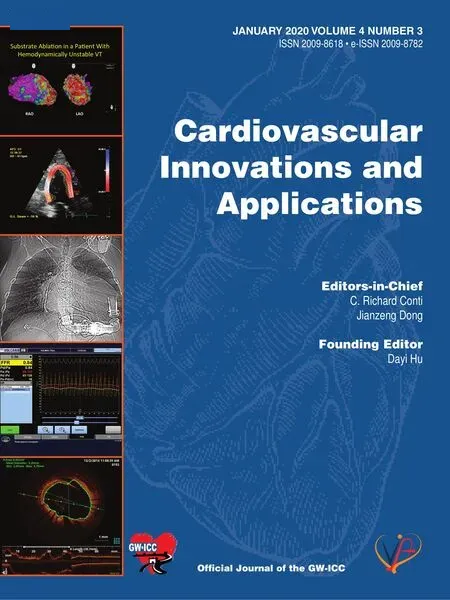A Giant Right Atrial Myxoma with Blood Supply from the Left and Right Coronary Arteries:Once in a Blue Moon
Yichao Xiao ,Zhenfei Fang ,Xinqun Hu ,Qiming Liu ,Zhaowei Zhu ,Na Liu ,Xiaofan Peng and Shenghua Zhou
1 Department of Cardiology,The Second Xiangya Hospital of Central South University,Changsha,410011 Hunan,People’ s Republic of China
Abstract
Keywords:cardiac myxomas;coronary angiography;neovascularization
lntroduction
Cardiac myxomas are the commonest primary car -diac tumors,with an extremely low incidence of between 0.0017 and 0.19% [1].Although myxomas are histologically benign,fatal events can occasionally occur in the case of systemic and cerebral embolism.The clinical features dif fer depending on the size,location,structure,mobility,and fragility of the mass,and only about one-f fth of myxomas originate from the right chambers of the heart [1].Herein we present a rare case of a giant right atrial myxoma with blood supply from the left and right coronary arteries and the multimodality imaging features.
Case Presentation
A 60-year-old woman was admitted because of recurrent attacks of chest tightness and shortness oflbreath during the previous 6 months especially after exer -cise.No remarkable abnormality was found on physical examination.About 3 months before her admission,a routine 12-lead electrocardiogram (Figure1) and transthoracic echocardiography (Figure2A) were performed after she had experienced a recurrent episode of chest tightness,and a giant mass in the right atrium was detected by echocardiography.To clarify the nature of the huge mass,[18]f uorodeoxyglucose PET/CT was performed,and the low-density mass in delayed imaging with the standard uptake value of 2.3 for the radioactive concentration was suggestive of imaging features of myxoma (Figure3A and B).Because of the ischemic characteristics of the electrocardiogram (T-wave inversion in precordial leads,nonspecif c ST-T abnormality shown in Figure1) and the patient ’ s age and presenting symptoms,preoperative selective coronary angiography was performed to assess the extent and severity of coronary stenosis,and showed no signif cant stenosis in the coronary arteries,but a strongly neovascularized right atrial mass that was supplied by two feeding vessels with multiple branches from the left and right coronary arteries (Figure4,Videos 1 and 2,Videos 1 and 2 may be downloaded at the following links:Video 1:http://cvia-journal.org/wp-content/uploads/2020/01/CVIA_196_VIDEO_1.avi and Video 2:http://cvia-journal.org/wp-content/uploads/2020/01/CVIA_196_VIDEO_2.avi).The myxoma was successfully excised with open heart surgery.Pathological analysis (Figure3C) conf rmed the diagnosis of atrial myxoma.Echocardiography performed 2 months and 3 years after surgery showed no evidence of myxoma recurrence (Figure2B and C).
Discussion
Cardiac myxomas,the commonest primary benign cardiac tumors,are extremely rare,with an incidence ranging from 0.0017 to 0.19% and only 15-20% of them originating from the right chambers of the heart [1].In the present case,we report a rare giant right atrial myxoma nearly filling the whole right atrium with left and right coronary artery blood supply.
The clinical diagnosis of cardiac myxoma is often challenging because of its nonspecif c clinical and radiological features,which may even mimic endocarditis or cancer [1].Typical symptoms and electrocardiogram features of myocardial ischemia of the patient should be due to the coronary steal phenomenon caused by neovascularization of the cardiac myxoma and intracardiac obstruction,which may cause right ventricular hypertrophy,pulmonary hypertension,right ventricular failure,hepatomegaly,etc.
Two-dimensional transthoracic echocardiography,which can accurately define the location,size,structure,and mobility of the mass,is the most preferred,commonly used,and cost-effective imaging technique to detect cardiac myxomas [2].However,differential diagnosis between cardiac myxoma and thrombus may be a great challenge as the attachment point is diff cult to determine,especially when the mass is so big that it fills the whole chamber of the heart.Two-dimensional transthoracic echocardiography may provide more accurate information on the mass for the differential diagnosis.
Fluorodeoxyglucose PET/CT is usually performed to rule out cardiac malignancies and assess systemic metastasis [3].However,it may make the diagnosis much more diff cult when no [18]f uorodeoxyglucose uptake is seen.In the present case,the standard uptake value of the radioactive concentration was low,but a clear outline and the attachment point were seen,which may facilitate exclusion of a diagnosis of cardiac thrombus.The indication for routine selective coronary angiography before open heart sur gery is still controversial [4].The main reasons for this invasive examination before surgery are (1) ruling out undiagnosed signif cant coronary artery disease especially for patients with high risk factors for coronary artery disease,(2) assessing the extent and severity of coronary stenosis for patients with diagnosed coronary artery disease to determine the optimal operating time since serious coronary stenosis may be f rst treated before surgery,and (3) assessing the vascular supply of the myxoma,which may change the approach,preferred methods,and blood-order -ing schedule for surgery.Tumor neovascularization,which was visible in up to 80% of myxoma cases [5,6],is not specif c for cardiac myxomas.Left-sided and right-sided myxomas were mostly supplied from the left circumf ex artery and the right coronary artery,respectively [7].Neovascularization originating from both the right coronary artery and the left circumf ex artery was reported in a left atrial myxoma [8],but no similar case in a right atrial myxoma has been reported to our knowledge[18].
Other imaging techniques [9],such as CT and cardiovascular MRI,could provide accurate infor -mation to assist the diagnosis of cardiac myxomas,but for one specif c individual it is essential to diagnose myxomas with fewer examinations.
Confl ict ofilnterest
The authors declare that they have no conf icts of interest.
 Cardiovascular Innovations and Applications2020年1期
Cardiovascular Innovations and Applications2020年1期
- Cardiovascular Innovations and Applications的其它文章
- Randomized Clinical Trials:Failure to Enter Patients
- Function of the Right Ventricle
- Physicians Leaving an Academic Position for Private Practice
- Associations between Vaspin Levels and Coronary Artery Disease
- Serum lrisin:Pathogenesis and Clinical Research in Cardiovascular Diseases
- Does Coronary Microvascular Spasm Exist? Objective Evidence from lntracoronary Doppler Flow Measurements During Acetylcholine Testing
